Maize Farming
The profit analysis for maize farming profit per acre reveals the total cost of NRs. 78,000 and total income of NRs. 120,000, yielding a net profit of NRs. 42,000 (calculated as *Profit = Total Income − Total Cost = 120,000 − 78,000*). Key cost drivers include land preparation (NRs. 15,000), fertilizers/manure (NRs. 15,000), and irrigation (NRs. 10,000), accounting for 51% of expenses. With an estimated yield of 4,000 kg/acre sold at NRs. 30/kg, revenue reaches NRs. 120,000, reflecting efficient production and strong market prices. The maize farming profit per acre demonstrates robust viability, achieving a 35% profit margin (NRs. 42,000) and a 53.85% return on investment (ROI), underscoring its financial feasibility under current conditions.

Land Preparation
Land preparation aims to create a fine seedbed for uniform germination and effective root penetration by following essential steps: clearing the land of previous crop residues, weeds, and debris; plowing to a depth of 15-20 cm to loosen the soil; harrowing to break clods and level the surface; and incorporating well-decomposed organic manure during preparation to enhance soil fertility.
Soil Type
Maize grows best in well-drained, loamy, or sandy loam soils with a pH between 5.5 and 7.0. Avoiding soggy or too compacted soils is essential to preventing obstacles to root growth and nutrient uptake.
Climatic Requirements
Climatic requirements are critical for maximizing maize farming profit per acre, with optimal growth achieved at temperatures of 21°C–27°C (tolerating up to 35°C), 500–800 mm of well-distributed rainfall (supplemental irrigation needed in low-rainfall zones), and 8–10 hours of daily sunlight as maize are a light-intensive C4 plant. Meeting these conditions ensures robust crop performance, directly influencing maize farming profit per acre through enhanced yield efficiency and reduced risk of climate-related losses.
Major Varieties
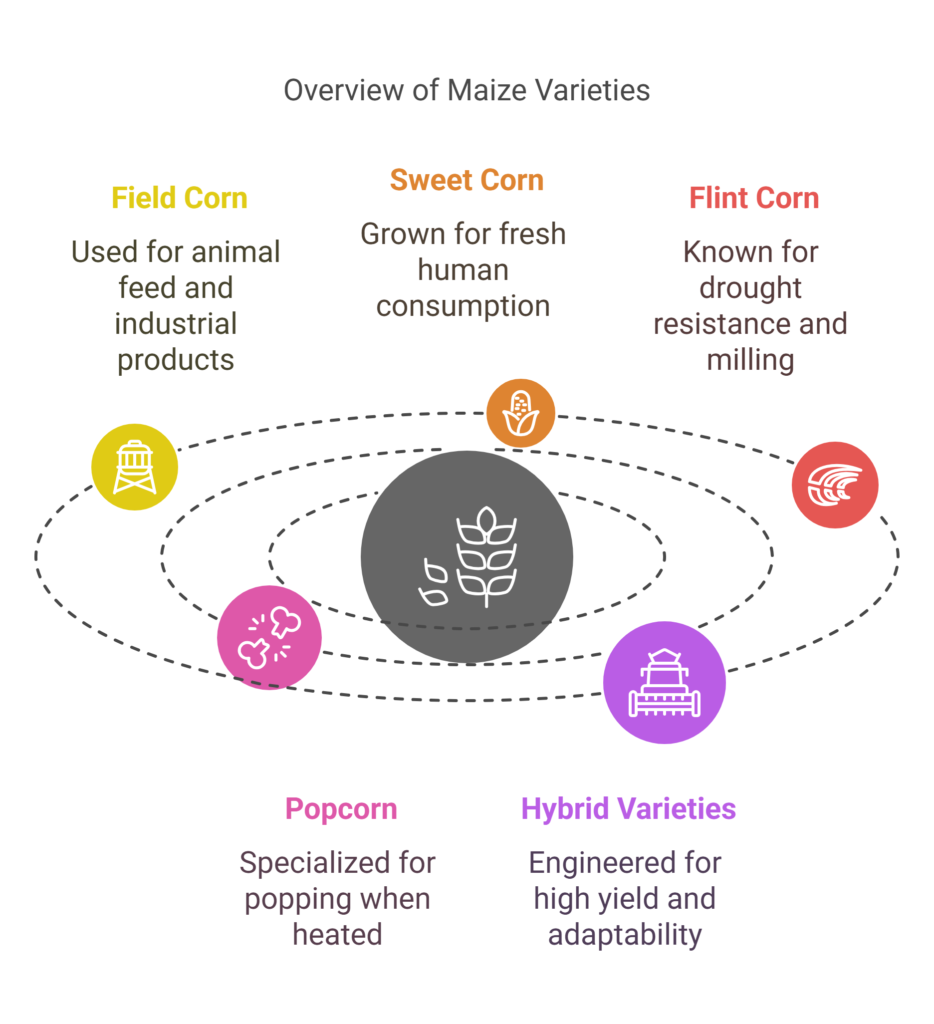
a) Field Corn
Primarily cultivated for grain production, field corn serves as a staple crop for animal feed, industrial uses (e.g., ethanol, corn syrup), and processed food products. It thrives in diverse climates and is valued for its high starch content and adaptability to large-scale farming.
b) Sweet Corn
Grown for fresh human consumption, sweet corn is harvested at the immature “milk stage” for its tender, sugary kernels. It requires precise timing for harvest and is popular in local markets, roadside stands, and fresh produce industries due to its short shelf life.
c) Flint Corn
Known for its hardy kernels and drought resistance, flint corn (e.g., H6213) is ideal for harsh climates with erratic rainfall. Its dense, vitreous grains make it suitable for milling into grits, hominy, or livestock feed in regions with challenging growing conditions.
d) Popcorn
A specialized variety cultivated for its unique ability to “pop” when heated, popcorn features small, hard kernels with a moisture-sealed hull. It demands careful drying and storage practices to retain popping quality and is primarily grown for snack food markets.
e) Hybrid Varieties
Engineered for traits like high yield, pest resistance, and climate adaptability, hybrids such as Ganga 5, Deccan 103, and Pioneer 30V92 dominate modern farming. These varieties are tailored to specific agro-climatic zones, offering farmers improved productivity and resilience against biotic/abiotic stresses.
Farmers should prioritize local climate compatibility (e.g., rainfall, temperature), soil fertility, and intended use (grain, fodder, silage) when choosing varieties to optimize profitability and sustainability in maize farming.
Seed Selection
Effective seed selection is critical for successful maize farming, requiring certified seeds with a high germination rate (above 90%) to ensure crop establishment. Farmers should prioritize disease-resistant and drought-tolerant varieties tailored to local climatic and soil conditions to mitigate risks and enhance adaptability. Additionally, seeds must be physically inspected for uniformity in size, vibrant color, and absence of damage, cracks, or pest infestations, as these factors directly influence seedling vigor, field performance, and overall yield potential.
Seed Rate per Acre
The ideal seed rate per acre for growing maize is 8–10 kg, taking into account variables like planting technique, germination rate, and seed size. Maintaining 60 cm between rows and 20 cm between plants is essential for proper root development, light penetration, and ventilation. By allowing for roughly 33,725–35,000 plants per acre, this arrangement (60×20 cm) strikes a balance between population density and resource efficiency.
Following these recommendations improves pest/disease control, reduces competition for nutrients and moisture, and increases potential yield. Planters and seed drills should be calibrated to distribute seeds uniformly because irregular spacing can result in overpopulation or underuse of field space, which will negatively affect crop uniformity and harvest quality.
Planting
Maize planting should ideally commence at the onset of the rainy season or following the first substantial rainfall to leverage soil moisture for germination and early growth. For uniform crop establishment, line sowing is recommended, which can be executed manually by dibbling (placing seeds in small holes) or mechanically using a tractor-drawn ridger seed drill to ensure precision and efficiency. Seeds must be sown at a depth of 3–4 cm to protect them from desiccation, predation, or exposure while maintaining adequate soil contact for moisture absorption.
Prior to planting, seeds should be treated with fungicides (e.g., carbendazim) or bio-control agents (e.g., Trichoderma) to suppress soil-borne pathogens like Fusarium or Pythium, which can compromise seedling health. Adherence to these practices—timely sowing, optimal spacing (60×20 cm), and seed treatment—enhances root development, reduces disease risks, and promotes uniform canopy growth, all of which are critical for maximizing yield potential and ensuring crop resilience under variable field conditions.
Irrigation
Irrigation frequency in maize cultivation varies based on soil type and climatic conditions, with sandy soils typically requiring more frequent watering every 5–7 days to compensate for rapid drainage, while loamy soils can sustain longer intervals of 8–12 days between watering sessions. Regardless of soil type, it is critical to avoid water stress during key growth phases such as tasseling and silking, as adequate moisture during these stages directly influences pollination success, kernel development, and overall yield.
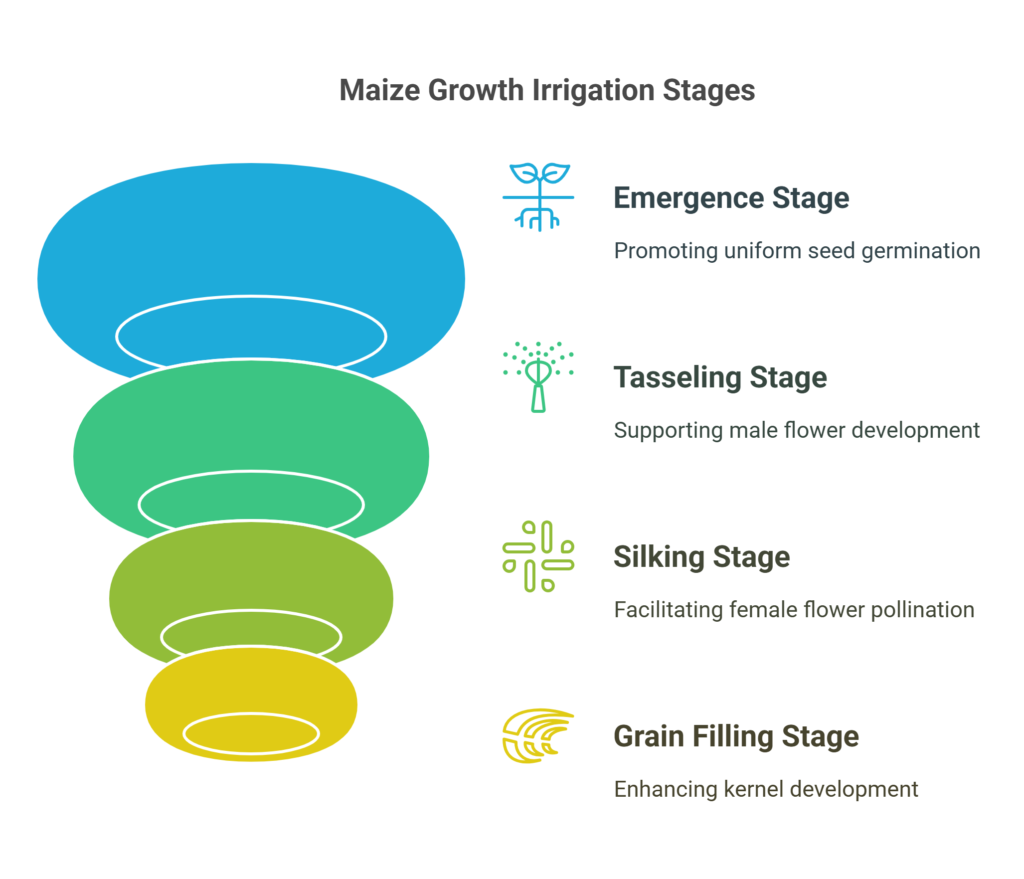
Irrigation at Key Growth Stages of Maize:
a). Emergence Stage
Irrigation during the emergence stage of maize ensures uniform seed germination and seedling establishment by maintaining adequate soil moisture, which softens the seed coat and activates enzymatic processes essential for sprouting. Dry conditions at this stage can delay or reduce germination rates, while excessive water may lead to seed rot or soil crusting, both of which physically hinder seedling emergence and compromise early crop uniformity.
b). Tasseling Stage
Irrigation during the tasseling stage of maize is critical to support the development of male flowers (tassels) and promote stalk elongation, ensuring robust structural growth. Water stress at this phase can severely reduce pollen production and viability, leading to poor pollination and fewer kernels. Adequate irrigation guarantees that tassels emerge fully and synchronize with the emergence of silks (female flowers), a vital alignment for successful fertilization. By maintaining optimal soil moisture, farmers safeguard the plant’s reproductive processes, directly influencing yield potential and crop uniformity.
c). Silking Stage
The silking stage in maize is pivotal for facilitating the emergence of silks (female flowers) and their ability to receive pollen, with adequate moisture ensuring silks remain hydrated to effectively capture pollen grains. Drought during this phase causes silks to desiccate, leading to incomplete fertilization and “missing kernels,” significantly reducing yield. Recognized as the most moisture-sensitive stage in maize cultivation, timely irrigation is essential to maintain silk viability, synchronize pollination with tassel activity, and safeguard grain formation, directly determining the crop’s final productivity.
d). Grain Filling Stage
The grain filling stage in maize is critical for driving starch accumulation and kernel development, relying on sustained photosynthesis and efficient nutrient translocation to the developing grains. Water deficits during this period reduce kernel size and weight, resulting in shriveled grains and diminished yields, while overwatering can delay physiological maturity or trigger lodging (stalk bending), compromising harvest quality. Balanced irrigation ensures optimal moisture for carbohydrate synthesis and grain plumpness, striking a delicate equilibrium between maximizing yield and avoiding water-related stress or structural damage to the crop.
Fertilizer and Manure
Fertilizer application should be guided by a soil test to ensure balanced nutrient management.
Basal Application
Nutrient Rates (per acre)
10–15 tons of farmyard manure (FYM) per acre.
Nitrogen (N): 60–70 kg
Phosphorus (P₂O₅): 28–35 kg
Potassium (K₂O): 20–25 kg
Zinc Sulphate (ZnSO₄): 8 kg
Iron Sulphate (FeSO₄): 8 kg
Borax (Na₂B₄O₇·10H₂O): 3 kg
Application Method
Mix one-third of the total nitrogen (20–23 kg N) with the entire quantity of phosphorus (P₂O₅), potassium (K₂O), and micronutrients (ZnSO₄, FeSO₄, borax) into the soil at sowing.
Top Dressing
Top dressing in maize cultivation involves strategically splitting the remaining two-thirds of nitrogen (40–47 kg N per acre) into two equal applications to optimize nutrient uptake and crop performance. The first split (20–23.5 kg N) is applied at the knee-high stage (4–6 weeks after planting), coinciding with rapid vegetative growth and stem elongation, to enhance leaf development and photosynthesis.
The second split (remaining 20–23.5 kg N) is applied during tasseling, a critical phase for grain initiation, to support pollen viability, cob formation, and starch accumulation in kernels. This phased approach ensures nitrogen availability aligns with the crop’s peak demand periods, minimizes losses from leaching or volatilization, and improves fertilizer-use efficiency. Farmers typically apply nitrogen through side-dressing (placing fertilizer 5–7 cm deep near plant roots) or via fertigation, ensuring timely assimilation for robust yield outcomes. Proper top-dressing practices are vital for balancing vegetative and reproductive growth, ultimately driving higher productivity and grain quality.
To optimize nutrient management in maize cultivation, soil pH adjustments may be necessary in alkaline soils to enhance zinc and iron availability, with chelated forms of these micronutrients recommended if their uptake is limited. Additionally, careful regulation of boron application is crucial to avoid toxicity risks, ensuring borax rates remain within prescribed limits. Meanwhile, nitrogen top-dressing should be precisely timed—particularly during critical growth stages like stalk development and tasseling—to bolster stalk strength and promote robust kernel filling.
Weed Control
a) Manual Weeding
Manual weeding involves physically removing weeds through hand-pulling or using tools like hoes, typically performed 2–3 times at 15–20 day intervals after sowing. This method is most effective during the early growth stages (up to 30–45 days) when maize plants are vulnerable to weed competition. Manual weeding ensures precise removal of invasive plants without chemical interference, preserves soil structure, and minimizes damage to young maize roots. However, it is labor-intensive, time-consuming, and costly for large-scale operations.
b) Chemical Control
Chemical weed management employs herbicides such as pre-emergence (e.g., Atrazine, applied before weed germination) or post-emergence (e.g., Pendimethalin, used after weeds sprout but before maize reaches 30–40 cm height). Pre-emergence herbicides create a protective barrier in the soil, suppressing weed seeds, while post-emergence options target actively growing weeds. Proper calibration, timing, and adherence to dosage guidelines are critical to avoid phytotoxicity to maize plants. Chemical control offers efficiency and scalability but requires careful handling to mitigate environmental and health risks.
c) Mulching
Mulching involves covering the soil surface with organic materials (e.g., straw, dried leaves) or synthetic sheets (plastic mulch) to block sunlight, suppress weed germination, and retain soil moisture. Organic mulches also enrich soil fertility as they decompose, while plastic mulch aids in temperature regulation. This method reduces reliance on labor or chemicals, conserves water, and enhances crop resilience, particularly in drought-prone areas. However, initial setup costs and material availability can limit its feasibility for resource-constrained farmers.
Pest and Disease Management
Common pests
a). Stemborers
Stemborers, a major pest in maize farming, can be managed using neem-based sprays (e.g., neem oil or neem cake extracts) that disrupt larval growth and feeding by acting as antifeedants or growth regulators. Alternatively, Bacillus thuringiensis (Bt) formulations—a biological insecticide containing cry proteins—target the larvae’s digestive systems, causing mortality within 48–72 hours.
Management
Apply chlorantraniliprole 18.5% SC (Suspension Concentrate), 60–80 ml per acre mixed with 200–250 liters of water as a foliar spray, ideally during early infestation stages or as a preventive measure at the vegetative stage, typically 15–25 days after sowing. For 0.4% GR (Granules), apply 10–15 kg per acre by broadcasting the granules uniformly in the soil during sowing or the early growth stages.
Apply neem sprays every 10–15 days during early infestation stages, focusing on the base of plants where larvae reside. Bt is most effective when sprayed during cooler hours (early morning or late evening) to avoid UV degradation. Combining these methods with cultural practices (e.g., crop rotation, destruction of crop residues) enhances control while minimizing chemical reliance.
b). Fall armyworm
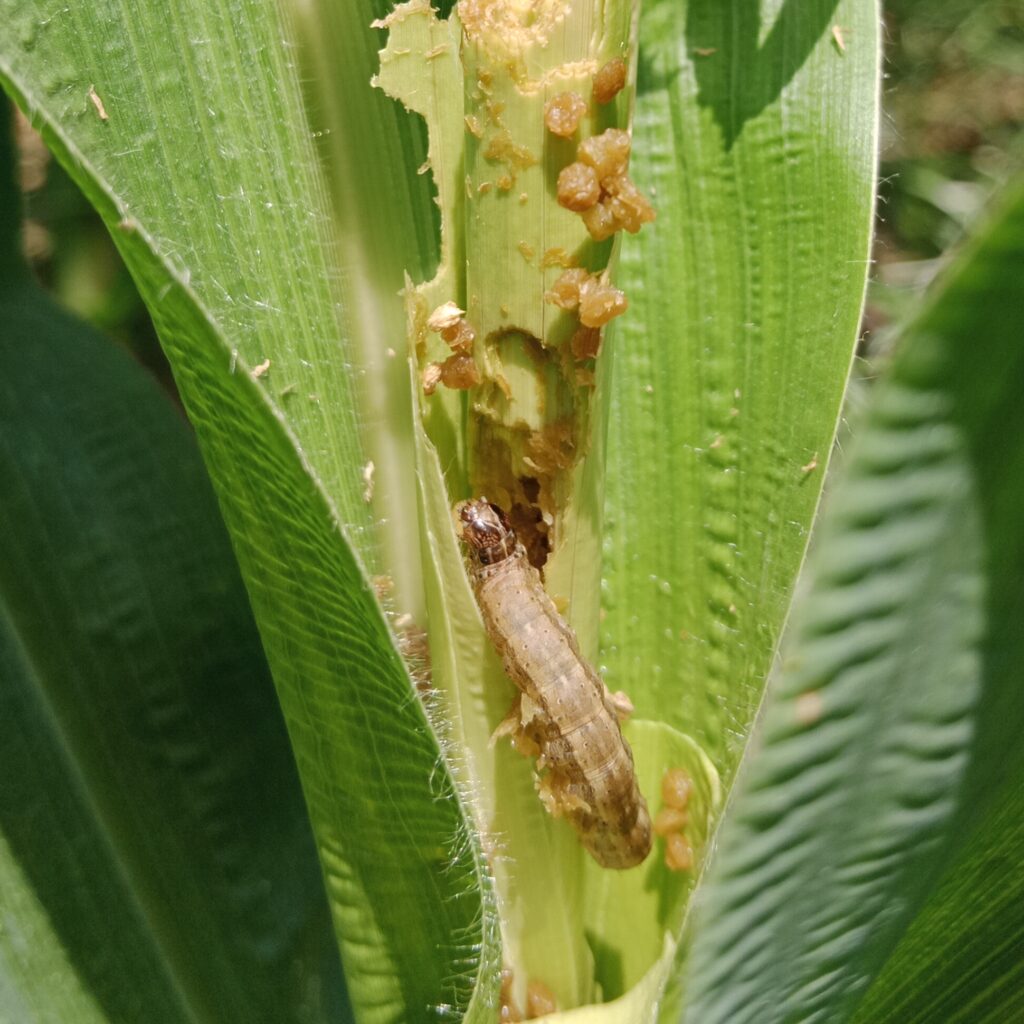
The invasive fall armyworm, known for rapid crop devastation, requires timely intervention using insecticides like Spinosad (a natural neurotoxin derived from Saccharopolyspora spinosa) or Emamectin Benzoate (a synthetic avermectin). Spinosad acts on the pest’s nervous system, causing paralysis and death, and is effective against young larvae when applied at 0.4–0.5 ml/liter.
Emamectin Benzoate, applied at 0.25–0.5 g/liter, disrupts neurotransmission and is ideal for moderate to severe infestations. Spray during early larval stages (1st–3rd instar) for maximum efficacy, targeting the whorl and undersides of leaves. Integrate chemical control with pheromone traps, intercropping with repellent plants (e.g., marigold), and field sanitation to reduce pest populations and resistance risks.
Moreover, apply automobile grease in the leaves completely control the fall armyworm after 15 days.
Common diseases
a). Downy Mildew
Metalaxyl-based fungicides (e.g., 2-3 g/kg of seed) are used to treat seeds for downy mildew, which is caused by the fungus Peronosclerospora spp. and systematically shields seedlings from early infection. This preventative action lessens field outbreaks by interfering with fungus development and spore germination. To stop the spread of the disease, combine seed treatment with crop rotation, stay away from soggy soils, and eliminate sick plants.
b). Maize Streak Virus (MSV):
Maize streak virus, transmitted by leafhoppers (Cicadulina spp.), is controlled by planting MSV-resistant hybrids (e.g., DK 777, PAN 53) and managing vectors through insecticides (e.g., imidacloprid) or biological agents like Beauveria bassiana. Destroy weed hosts near fields and use reflective mulches to deter leafhoppers, minimizing viral transmission and safeguarding yield.
Harvesting
Maize is ready for harvest when cobs develop a yellowish-brown hue, kernels harden (tested by pressing a thumbnail into a kernel), and moisture content reaches 20–25%. Harvesting can be done manually (hand-picking cobs) for small-scale farms or mechanically using combine harvesters for large fields, which simultaneously cut, thresh, and clean grains. Post-harvest, kernels must be dried to 12–14% moisture content using sun-drying or mechanical dryers to inhibit mold growth, prevent aflatoxin contamination, and ensure safe, long-term storage. Timely harvesting and proper drying are critical to preserving grain quality, market value, and minimizing post-harvest losses.
Yield Per Acre
Maize typically yields 30–50 quintals (3–5 metric tons) per acre, influenced by factors such as variety choice, agronomic practices (e.g., irrigation, fertilization), and environmental conditions (rainfall, temperature). Hybrid varieties, when cultivated under optimal management—precision planting, balanced nutrient application, and integrated pest control—can achieve high-yield potentials of 80–100 quintals (8–10 metric tons) per acre. This variability underscores the importance of adopting climate-resilient seeds, advanced farming techniques, and timely interventions to maximize productivity and profitability in maize farming.
Cost of Investment Per Acre of Maize Farming
| S.N. | Categories | Cost (NRs.) | |
| 1 | Land Preparation (plowing, leveling) | 15,000 | |
| 2 | Seed rate per acre | 7,000 | |
| 3 | Labor Costs (Planting) | 6,000 | |
| 4 | Fertilizers and Manure | 15,000 | |
| 5 | Irrigation | 10,000 | |
| 6 | Weed Control (pre & post-emergence) | 5,000 | |
| 7 | Pest & Disease Control | 8,000 | |
| 8 | Harvesting & Threshing | 7,000 | |
| 9 | Miscellaneous Costs | 5,000 | |
| Total Cost | 78,000 | ||
Income from one Acre Maize Farming
| Particulars | Estimated Yield | Market Price (NRs/kg) | Total Income (NRs.) |
| Maize Production | 4,000 kg | 30 | 120,000 |
Analysis of Maize Farming Profit Per Acre
The profit analysis reveals that with a total cost of NRs. 78,000 and a total income of NRs. 120,000, the net profit amounts to NRs. 42,000, calculated as Profit = Total Income − Total Cost = 120,000 − 78,000 = NRs. 42,000.
The primary cost drivers in maize farming are land preparation (NRs. 15,000), fertilizers/manure (NRs. 15,000), and irrigation (NRs. 10,000), collectively representing 51% of total expenses. Revenue potential is robust, with an estimated yield of 4,000 kg/acre sold at NRs. 30/kg, generating NRs. 120,000 due to efficient production and favorable market rates. The venture demonstrates strong profitability, achieving a 35% profit margin (NRs. 42,000 net profit) and a 53.85% return on investment (ROI), confirming its financial viability under current conditions.
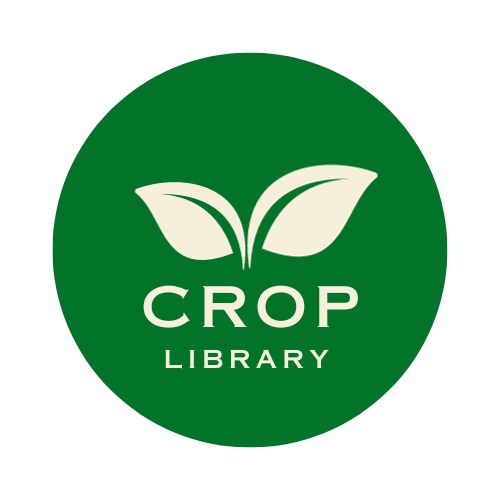
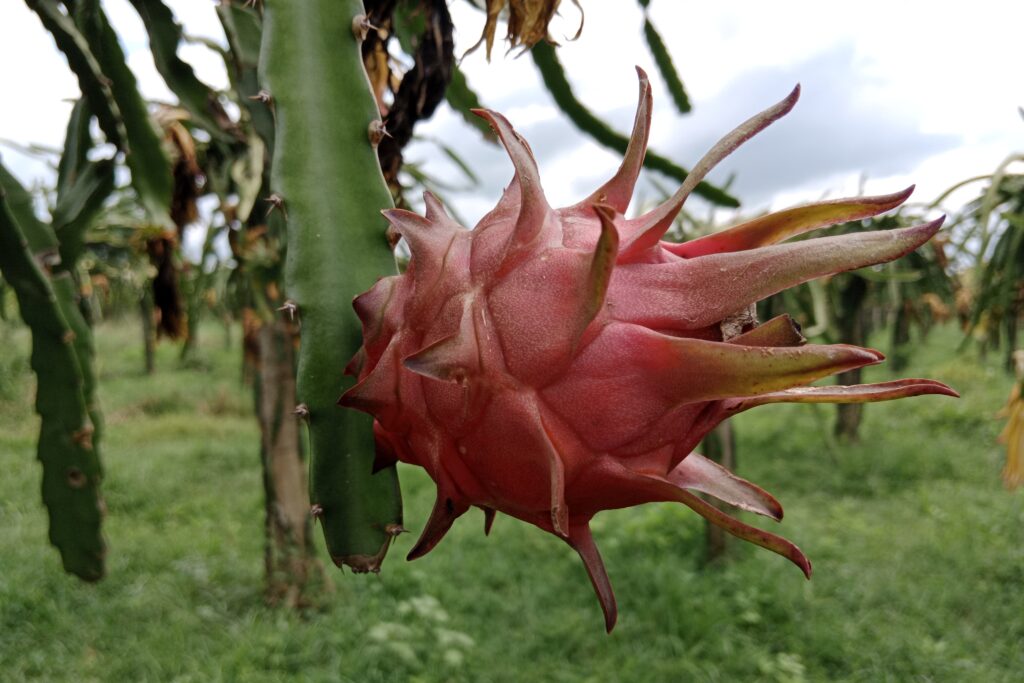
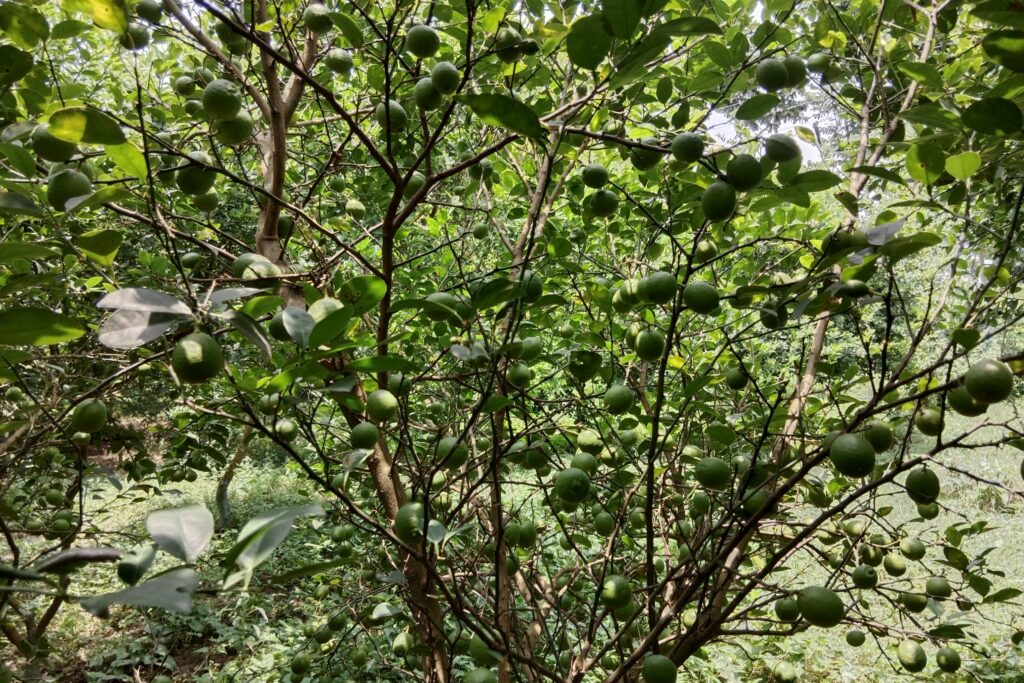
Excellent.am very new in the farming area.